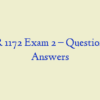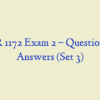Description
JUS 3330 Final Exam with Answers (70/70 Points)
- House v. Bell is an atypical felony prosecution because his conviction was __________ on appeal.
- The public often blames __________ for allowing guilty defendants to go free on “technicalities”.
- The actions of law enforcement have a direct impact on the workload of __________.
- __________ courts are divided into major and lower.
- Common law developed into a system of law made primarily by __________.
- A ruling in a previous case that serves as a guide in subsequent cases is known as a __________.
- The __________ is the supreme and fundamental law of the land.
- The __________ is the collective name for the first ten Amendments of the United States Constitution.
- The United States has a __________ court system, which means that it has one national court system plus separate court systems in each of the 50 states and the District of Columbia.
- __________ jurisdiction means that a court has the authority to try a case and decide it.
- The legal process in which officials of one state or country surrender a criminal offender to another is known as __________.
- A violation or dispute of __________ jurisdiction if a California court were to try a crime that happened in Oregon.
- Courts that hear a variety of cases related to families are termed __________ relations courts.
- Trial courts of __________ jurisdiction are sometimes referred to as inferior courts or lower courts.
- The most common type of civil case involves __________ relations.
- The principal objective of a __________ court system is a shift in judicial administration from local control to centralized management.
- The __________ of court controls the scheduling of cases and keeps the judge apprised of the relevant details of a given case.
- To one side of the bench sits the court __________ , whose machine mysteriously makes a shorthand record of the proceedings.
- The __________ is responsible for maintaining order in the courtroom.
- __________ justice explains why few cases receive individual treatment.
- The office of the prosecutor is part of the __________ branch of government.
- A prosecutor is a lawyer as well as a(n) __________ of the court, whose primary responsibility is to see that justice is served.
- The U.S. Department of Justice is headed by the U.S. __________ , who is a member of the president’s cabinet.
- The U.S. Solicitor General is often referred to as the __________ Justice.
- __________ are defendants who are too poor to pay for a lawyer.
- The __________ Amendment states that “in all criminal prosecutions the accused shall enjoy the right… to have assistance of counsel for his defense.”
- In the case of __________ the right to counsel was extended to juvenile-court proceedings.
- The U.S. Supreme Court, in the case of __________ , ruled that criminal defendants in federal cases were entitled to court-appointed counsel if they were too poor to hire their own attorney.
- A judge’s office is commonly referred to as __________.
- Awarding jobs to friends, family, or members of a political party is referred to as ___________.
- Judges who fail to move their __________ may be transferred to less desirable duties (for example, traffic court or juvenile court).
- __________ courtesy refers to the expectation of a Senator to be consulted before the President nominates a person for a judicial vacancy in the Senator’s state.
- Researchers estimate that over 70 percent of all serious offenses are committed by roughly seven percent of offenders, a group commonly referred to as __________.
- Three characteristics of defendants—sex, poverty, and ___________ – figure prominently in discussions of crime and crime policy.
- Typical felony defendants are predominantly drawn from what sociologists call the urban __________.
- The association of crime with __________ helps explain, in part, why the overwhelming number of crimes—primarily burglary, theft, and drug sale—are economically motivated.
- According to the FBI, property crimes outnumber violent crimes by a ratio of __________ to one.
- The Uniform Crime Report’s Type I offenses are also referred to as __________ crimes.
- Drug crimes are categorized as Type __________ offenses in the Uniform Crime Reports.
- Through the charging decision, the __________ controls the doors to the courthouse.
- Supporters of the Crime __________ Model argue that bail should be used to protect society.
- Where a property bond is posted, the equity in the property used as collateral must be the __________ amount of the bond.
- Release on __________ is the type of pretrial release typically granted for defendants who are unlikely to flee, often because they have substantial ties to the community. No monetary bail is required.
- Trial court judges have virtually unlimited __________ in determining the amount of bail to set.
- The U.S. Supreme Court’s decision in the __________ case provides the best example of the Supreme Court’s due process revolution that greatly changed how crimes are prosecuted.
- The informal and formal exchange of information between prosecution and defense is referred to as __________.
- __________ evidence is any evidence that may be favorable to the defendant at trial either by tending to case doubt on the defendant’s guilt or tending to mitigate the defendant’s culpability, thereby potentially reducing the defendant’s sentence.
- A(n) __________ defense means that the defendant claims the crime was committed while the s/he was somewhere else, and thus could not have been the perpetrator.
- __________ can best be defined as the process through which a defendant pleads guilty to a criminal charge with the expectation of receiving some benefit from the state.
- One type of plea agreement is termed __________ bargaining. In return for the defendant’s guilty plea, the prosecutor allows the defendant to plead guilty to a less serious charge than the one originally filed.
- One type of plea agreement is called __________ bargaining. In return for the defendant’s plea of guilty to one or more charges, the prosecutor dismisses the remaining charges.
- A common form of a plea agreement is called __________ bargaining. A plea of guilty is entered in exchange for leniency in sentencing.
- The primary purpose of the jury is to prevent __________ by the government.
- Trial juries are also called __________ juries to differentiate them from grand juries.
- The __________ Amendment guarantees that “in all criminal prosecutions, the accused shall enjoy the right to a speedy and public trial, by an impartial jury.”
- Just ___________ theory is similar to retribution.
- The idea that fear of punishment will prevent crime is called __________.
- The deterrent goal of criminal punishment presumes that the threat of punishment will prevent the general population from engaging in the proscribed conduct.
- Judges sometimes consider __________ investigation reports when deciding on a sentence.
- An example of a(n) __________ factor in sentencing may be that the victim was particularly vulnerable or that the defendant’s crime was particularly heinous.
- Examples of __________ factors in sentencing may include the youth of the defendant, lack of mental capacity, and full-time stable employment.
- A case in which all appellate court judges participate is called a(n) __________ hearing.
- The Fifth Amendment ban on __________ generally prohibits retrial of a person who has already been convicted of the same crime.
- Most appellate decisions are rendered by three judges __________.
- Lower courts typically try cases involving misdemeanors, infractions, ordinance violations, and __________ offenses.
- __________ are crimes that are typically punishable by a maximum of less than one year in jail.
- City laws or regulations are referred to as __________.
- The doctrine of parens __________ authorizes the state to act as a parent.
- The first juvenile court was established in __________ County, Illinois in 1899.
- The juvenile court is a continuing legacy of the __________ Movement.






